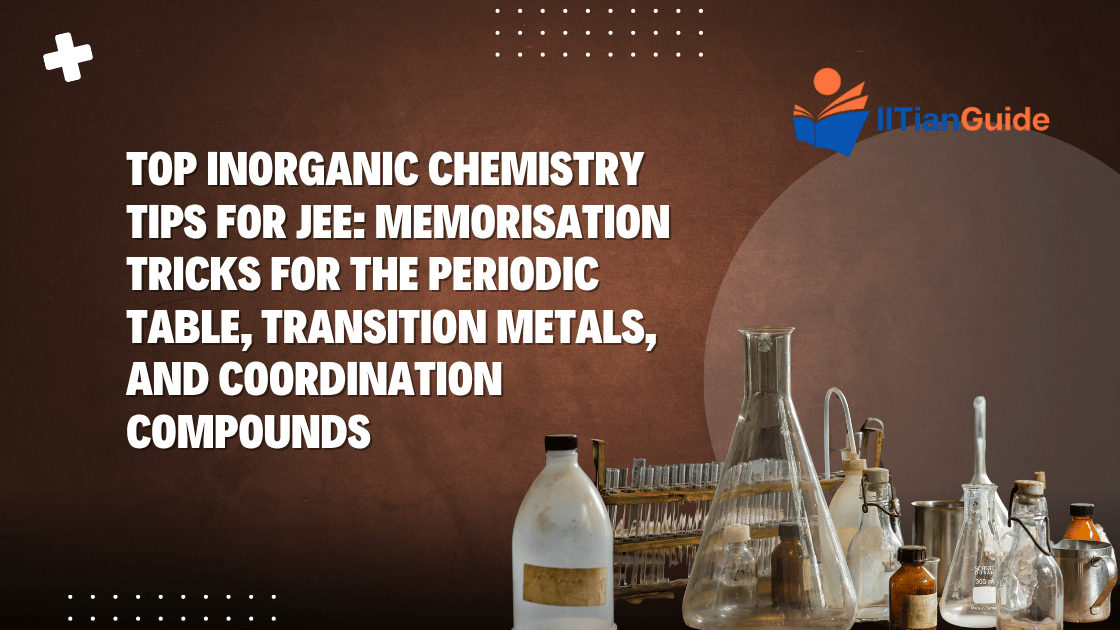Top Inorganic Chemistry Tips for JEE: Memorisation Tricks for the Periodic Table, Transition Metals, and Coordination Compounds

Inorganic Chemistry often feels overwhelming.
The vastness of the periodic table, the confusing trends in d- and f-block elements, and the complex nature of coordination compounds can stress out even top-performing students.
But here’s the truth—Inorganic Chemistry is memory-based. Once you understand how to memorise effectively, it becomes manageable and even scoring.
This blog will give you powerful tips, proven mnemonics, and strategic memorisation hacks that JEE toppers use. From periodic trends to transition metal chemistry and coordination compounds—we’ve got it all covered.
Why Focus on Inorganic Chemistry for JEE?
- Inorganic Chemistry is high scoring.
- Questions are mostly fact-based and repetitive.
- With proper memorisation and revision, you can answer them in less than a minute.
- Many toppers secure full marks in Inorganic sections by just focusing on NCERT and smart memorisation.
Section 1: Periodic Table Memorisation Tricks
The Periodic Table forms the foundation of all Inorganic Chemistry. Understanding it simplifies everything else.
1. Learn Group-wise, Not Period-wise
Focus on vertical groups, not rows. Groups show similar chemical behaviour.
Example Mnemonic for Group 1 (Alkali metals):
Li Na K Rb Cs Fr
→ “LiNa Ki Ruby Cse Friends”
Example Mnemonic for Group 17 (Halogens):
F Cl Br I At Ts
→ “Foolish Clever Brother Is At Top Spot”
2. Mastering Periodic Trends: Mnemonics
|
Property |
Trend |
Mnemonic |
|
Atomic size |
Decreases across period, increases down group |
“Size shrinks left to right” |
|
Ionisation energy |
Increases across period |
“Energy increases with anger (left to right)” |
|
Electronegativity |
Increases across period |
“Fluorine is the king of attraction” |
3. Colour Code with Visual Maps
Use printouts of the periodic table and colour-code:
- Red for metals
- Green for metalloids
- Blue for non-metals
Keep it pinned to your wall for daily passive revision.
Section 2: Transition Metal Chemistry – Scoring and Strategic
Transition metals (d-block) are tricky but important.
1. Focus on Electronic Configurations First
Use this trick:
Cr (Z=24): [Ar] 3d⁵ 4s¹
Cu (Z=29): [Ar] 3d¹⁰ 4s¹
Why? Half-filled and fully filled d-orbitals offer extra stability.
Remember:
“Craves Stability” → Chromium and Copper deviate to stay stable.
2. Memorising Oxidation States
Mnemonics for Common Oxidation States:
|
Element |
Oxidation States |
Mnemonic |
|
Mn |
+2, +4, +7 |
“Manganese is 2 Good 4 Heaven (7)” |
|
Fe |
+2, +3 |
“Fe is Fair at 2 and 3” |
Learn variable oxidation states through daily flashcards. This helps in understanding reactions.
3. Coloured Compounds of Transition Metals
Colour comes from d-d transitions.
|
Compound |
Colour |
|
CuSO₄ · 5H₂O |
Blue |
|
NiCl₂ |
Green |
|
KMnO₄ |
Purple |
|
FeCl₃ |
Yellow-brown |
Use flashcards with compound on one side, colour on the other.
Revise for 5 mins daily.
Section 3: Coordination Compounds – Mastering the Framework
This chapter often scares students. But with the right flow, it’s easy.
1. Learn the Nomenclature First
Use this rule:
Cation name first, then Anion name.
Ligands in alphabetical order, followed by metal and its oxidation state.
Example:
[Co(NH₃)₆]Cl₃ → Hexaamminecobalt(III) chloride
2. Types of Ligands
|
Ligand |
Type |
Examples |
|
Monodentate |
One donor atom |
NH₃, H₂O, Cl⁻ |
|
Bidentate |
Two donor atoms |
Ethylenediamine |
|
Polydentate |
Multiple donor atoms |
EDTA⁴⁻ |
Use this mnemonic:
“Mono is one, Bi is two, Poly sticks like glue”
3. Crystal Field Theory (CFT)
Understand high spin vs low spin complexes.
Focus on octahedral vs tetrahedral crystal field splitting.
Visual diagrams help:
- Draw d-orbital splitting diagrams.
- Write examples under each type.
CFT is asked every year. Don’t skip it.
Proven Study Strategies to Boost Inorganic Memory
1. Pomodoro Technique
- 25 mins of focused study
- 5 mins short break
- After 4 sessions, take a longer 15–20 min break
Use it to memorise and revise flashcards, oxidation states, or compound colours.
2. Mind Maps
Create branching maps for:
- Periodic trends
- Types of ligands
- Colour of compounds
Stick them on your study wall.
3. Revision Frequency (The 1-3-7 Rule)
- Revise 1 day, 3 days, and 7 days after learning something new.
- Then revise weekly.
This schedule moves info from short-term to long-term memory.
Conclusion
Inorganic Chemistry, though heavy on facts, is your shortcut to high scores in JEE—if approached with the right techniques.
Focus on:
- Group-wise periodic table memorisation
- Mnemonics for trends and transition elements
- Flashcards for compounds, colours, and oxidation states
- Pomodoro and spaced revision to retain concepts longer
Stick to NCERT, use smart tools, and you will master Inorganic Chemistry.
Frequently Asked Questions (FAQs)
Q1. What is the best way to memorise the periodic table for JEE?
Answer: Use group-wise mnemonics, colour-coded charts, and daily passive revision. Don’t try to cram all at once. Break it down by groups and blocks.
Q2. How important are coloured compounds in JEE Inorganic Chemistry?
Answer: Very important. They’re frequently asked in MCQs. Focus especially on transition metal salts and complexes. Use flashcards and regular testing.
Q3. Should I study from other books or just NCERT?
Answer: NCERT is sufficient for Inorganic Chemistry, especially for JEE Main. But for JEE Advanced, you can refer to J.D. Lee (adapted version) for conceptual clarity.
Q4. How can I remember oxidation states of d-block elements?
Answer: Use mnemonics and revise regularly. Focus on common oxidation states like +2, +3, +4, +7. Use tables and tricks explained in this blog.
Q5. How often should I revise Inorganic Chemistry?
Answer: Use the 1-3-7 Rule. Revise 1 day after first learning, again after 3 days, and then after 7 days. Keep revising weekly to retain long-term memory.

